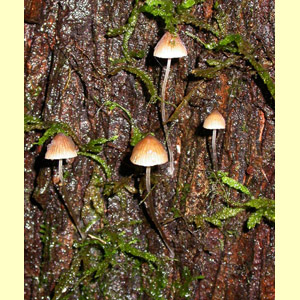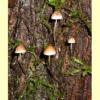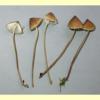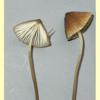
images/Mycenella_margaritispora/Mycenella_M209_OG_E5_on_tree_3Jul07_1.jpg



_AL_14_sml.jpg)
AL04_sml.jpg)
Diagnostic characters
Small agaric, growing on wood, with a white or cream to yellow spore print. Pileus brown or grey, dry or moist. Lamellae adnexed or adnate. Stipe central. Partial veil remnants absent. Spores hyaline, non-amyloid, with nodulose warts; germ pore absent. Cheilocystidia present. Lamellar trama regular. Pileipellis a cutis. Clamp connections present.
Similar genera
Looks like a Mycena in the field, but it is readily distinguished by the distinctly nodulose spores. The mycenoid Lyophyllum tylicolor group has spores with similar ornamentation, but that species grows on the ground and also differs in the absence of cystidia and the smooth hyphae in the pileipellis.
Citation
Mycenella (J.E.Lange) Singer, Bot. Mater. Sporov. Rast. Bot. Inst. Komarova Akad 4: 9 (1938).
Australian species
One species: Mycenella margaritispora.
Citation of species
Mycenella margaritispora (J.E.Lange) Singer, Lilloa 22: 291 (1951).
Australian distribution
N.S.W., Vic. and Tas.
Habitat
In native forests. Seems to prefer wet eucalypt forest and cool-temperate rainforest (with Nothofagus).
Substrate
Australian collections are all from wood (trunks of Nothofagus, Bedfordia or Acacia). Also noted in the Netherlands as growing among grasses and mosses.
Trophic status
Saprotrophic.
References
Boekhout, T. (1985), Notulae ad Floram agaricinum neerlandicum - IX. Mycenella, Persoonia 12: 427–440. [Description, B&W Illustration and Microcharacters of M. margaritispora from The Netherlands, and Key to the western European species]
Breitenbach, J. & Kränzlin, F. (eds) (1991), Fungi of Switzerland. Volume 3. Boletes and Agarics 1st part. Edition Mykologia, Lucerne. [Illustration, Description and Microcharacters of the European species M. bryophila]
Grgurinovic, C. (1993), First record of Mycenella (Xerulaceae) in Australia, Vict. Naturalist 110: 65–69. [Description, B&W Illustration and Microcharacters of M. margaritispora]
Moser, M. (1983), Keys to Agarics and Boleti (Polyporales, Boletales, Agaricales, Russulales). Roger Phillips, London. [Key to European species]
http://www.bioimages.org.uk/HTML/T49873.HTM [Illustration of the overseas species M. rubropunctata from United Kingdom]
